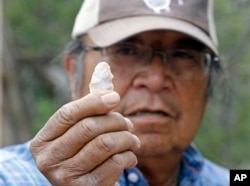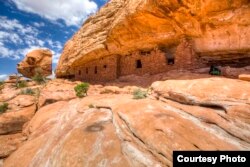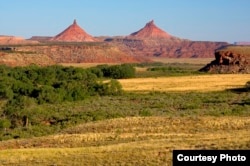For as long as Navajo healer Jonah Yellowman can remember – “all the way back to Creation” – southeastern Utah’s Bears Ears region has been central to the culture and religion of the Navajo, Hopi, Zuni, Ute Indian tribe, and Ute Mountain Ute people. Its tens of thousands of archeological sites date back 13,000 years.
“It’s sacred land,” said Yellowman, spiritual adviser to Utah Dine Bikeyah, a nonprofit organization working to protect the region’s cultural and natural resources. “Our ancestors are buried there. There are petroglyphs and stone markings there. We even have ancient sweat lodges and hogans,” referencing Navajo traditional wood and mud dwellings still used today for religious ceremonies.
“Bears Ears is where we gather herbs for medicine and for our ceremonies. And it’s where we get the firewood that we use to heat our homes in winter," he said.
In 2016, after intense lobbying by environmentalists and tribes, then-President Barack Obama proclaimed the Bears Ears National Monument and established a commission of tribal representatives to consult with the government on how the land should be used.
For more than a century, however, the region has also been home to non-Native farmers and ranchers who depend on Bears Ears for water and grazing their livestock. They were outraged over Obama’s move and, despite government reassurance, fear they will lose access to the area.
Gavin Noyes, executive director of Utah Dine Bikeyah, suggests racial tensions may also be at play. About 8,000 Navajo currently live in San Juan County, where Bears Ears is located, nearly half of the county’s total population of 15,000.
“There’s a new generation of Navajos, with college degrees and graduate degrees,” he said. “They are strong in number and sophisticated in their knowledge. And they’ve decided to take the reins of their future - and the non-Natives are terrified.”
Preservation versus utilization
Since the 19th century, “pot hunting” – the looting of Native American antiquities and graves – has been big business in the United States. In 1906, during Theodore Roosevelt's presidency, Congress passed the American Antiquities Act in an attempt to stop artifact stealing. The law gave U.S. presidents the authority to bypass Congress and designate historic landmarks as national monuments, protecting them from exploitation.
Since then, 16 presidents have exercised that privilege, designating nearly 130 national monuments, most still standing and managed by federal agencies. Some monument land is protected as park property, but the bulk is used for grazing, hunting, fishing and mining.
“Over in the neighboring county, directly to the west, President [Bill] Clinton came in 1996 and designated the Grand Staircase-Escalante National Monument, 1.7 million acres [688,000 hectares] of Utah canyon,” said Matt Anderson, policy analyst for the Coalition for Self-Government in the West, a project of the Salt Lake City-based Sutherland Institute.
“When he made that designation, he promised that grazing would remain at historical levels,” said Anderson. “But in the last 20 years, the Bureau of Land Management has cut the grazing by a third in that national monument. Ranching families have had to move out in droves, and in the summer of 2015, the local county had to declare a state of emergency.”
Anderson pointed out that other tribal groups in the area oppose monument status.
“A lot of the tribes complaining don’t even live at Bears Ears,” he said.
He also worries that national monument status encourages large numbers of tourists and he worries that the Bureau of Land Management and National Forest Service lack the budget to protect monument areas.
Anderson failed to mention, however, that the Clinton move interfered with plans to mine billions of tons of coal beneath Grand Staircase-Escalante National Monument.
And neighboring Bears Ears holds sizable deposits of uranium, along with copper and vanadium, which are used in making steel. Mining would boost the county’s faltering economy.
In January, Utah lawmakers appealed to President Donald Trump to rescind Obama’s proclamation and return Bears Ears to its former status.
On April 26, Trump called on the Department of the Interior (DOI) to review all national monuments larger than 4,047 hectares with an eye toward their status and use.
"The Antiquities Act does not give the federal government unlimited power to lock up millions of acres [hectares] of land and water, and it is time we ended this abusive practice," the president said.
On May 5, the agency announced a 15-day period for public comment on the debate, beginning May 12. Critics, including Senator Martin Heinrich (D-N.M.), a member of the Senate Committee on Energy and Natural Resources, say such a short public comment period could pose a challenge for tribal peoples who may not have access to the internet.
DOI Secretary Ryan Zinke traveled to Utah last week to meet with people on both sides of the issue and says he will make preliminary recommendations within 45 days. He has promised to keep an open mind.











